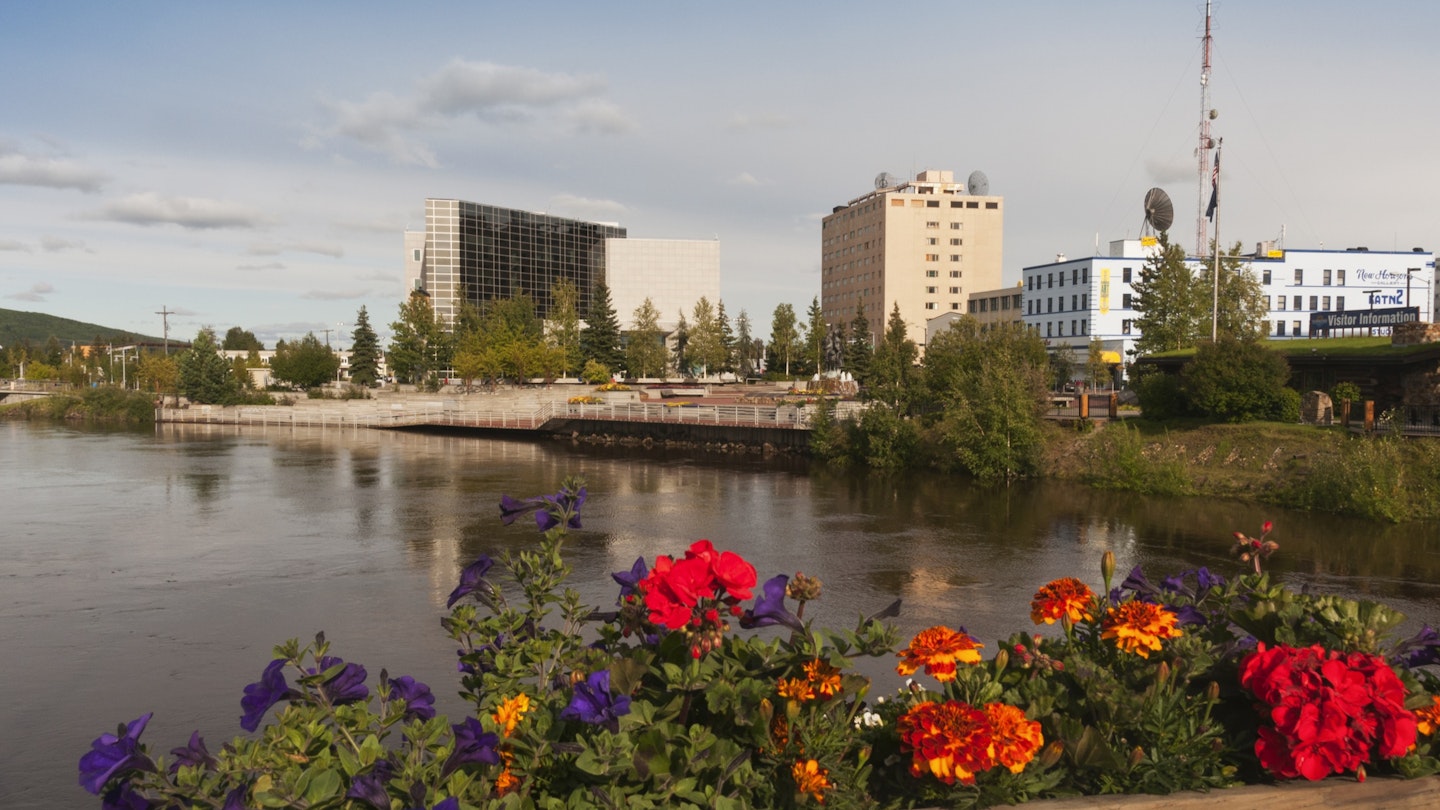Alaska frequently ranks high on travelers’ bucket lists due to its incredible experiences like Denali National Park, whale-watching adventures, and floating icebergs. However, further north lies the state’s “Golden Heart” — the under-the-radar city of Fairbanks.
In 1902, Felix Pedro struck gold in Fairbanks, a city where the sky itself sparkles like gems. Positioned at 65 degrees north latitude in Alaska’s interior, summer visitors to Fairbanks can immerse themselves in the Midnight Sun, enjoying 20-22 hours of daylight. Conversely, when winter comes, that sunlight is replaced by the mesmerizing aurora borealis.
Nevertheless, Fairbanks offers more than just the Northern Lights and the Midnight Sun. Visitors have the opportunity to discover native culture, explore fascinating museums, enjoy diverse wildlife, soak in hot springs, and access magnificent national parks beyond Denali.
Sunbathing at Midnight
From April 22 to June 21, Fairbanks locals and visitors embrace the increasing daylight, culminating in the Midnight Sun Festival, which occurs annually on the Sunday closest to the summer solstice. This free event, known as Alaska’s largest single-day festival, draws nearly 30,000 attendees. A four-block area surrounding Golden Heart Plaza showcases multiple stages with a variety of live performances spanning rock, rap, folk, ballet, and more.
In conjunction with the solstice, Fairbanks hosts a historical baseball game and the Midnight Sun 10K race. Notably, over 3,400 runners and walkers take to the streets at 10 PM, many donning quirky costumes.
Chasing the Northern Lights
As daylight fades from August 21 to April 22, the longer nights enhance the chances of witnessing the spectacular Aurora Borealis.
Fairbanks lies directly under the “Aurora Oval,” a ring-shaped zone where aurora activity is prevalent. Additionally, Fairbanks’ location in the interior allows for consistently clear nights, avoiding the cloud cover often found along the coast. On average, the Northern Lights are visible on about 9 out of 10 clear nights during any two-week winter period.
Chena Hot Springs Resort can enhance your experience, located just an hour outside Fairbanks and away from city lights. They offer wake-up calls to alert guests about the lights, provide snow cat rides to a heated “aurorium” cabin, and organize wilderness tours.
Native Culture
The Alaskan Athabascans are the indigenous people who inhabited the interior for centuries. In Fairbanks, the Tanana Chiefs Conference collaborates with the Convention & Visitors Bureau to present cultural programs at the Morris Thompson Center. These programs feature traditional craft and jewelry-making workshops alongside live performances by Alaska Native youth.
Moreover, visitors can participate in a tour of a reconstructed Athabascan village as part of the Riverboat Discovery Tour. Here, Alaska Native guides share insights into how the Athabascans thrived for millennia in cabins constructed from spruce logs, bark, and hides, particularly emphasizing the role of wildlife in providing sustenance and shelter amid the harsh Arctic climate.
Furthermore, every July, the World Eskimo-Indian Olympic Games attract native athletes and dancers from the United States, Canada, and Greenland. This four-day event features traditional competitions like the ear pull, blanket toss, and greased pole walk.
Unique Museums and History
In addition to its indigenous heritage, Fairbanks boasts a rich and diverse collection of museums and historical landmarks. Learn about the city’s gold rush history at Gold Dredge 8, where you can even pan for gold yourself.
The University of Alaska at Fairbanks’ Museum of the North showcases natural history exhibits, including the renowned Blue Babe, a 50,000-year-old mummified steppe bison, alongside an impressive collection of artwork ranging from 2,000 years ago to modern times.
Moreover, for those keen on automobiles, the Fountainhead Antique Auto Museum features nearly 100 rare, pre-World War II cars, all in working condition, dating from 1898 to 1936. Additionally, the Aurora Ice Museum stands as the world’s largest year-round ice environment, embellished with intricate ice carvings.
National Parks
Fairbanks serves as a strategic base for accessing numerous national parks. It is a mere two-hour drive to Denali National Park, or even more conveniently, visitors can take a daily ride via the Alaska Railroad.
Aside from Denali, flightseeing excursions provide access to Wrangell-St. Elias and Gates of the Arctic National Parks. Notably, Wrangell-St. Elias spans an impressive 13.2 million acres, making it the largest national park in the country, renowned for its glaciers and featuring nine of North America’s 16 tallest peaks.
Meanwhile, Gates of the Arctic National Park, located above the Arctic Circle, is predominantly accessible by float and bush planes. This remote wilderness area, devoid of roadways, offers an unparalleled opportunity to experience solitude amid nature.
With its strategic location in the heart of Alaska, Fairbanks acts as a basecamp for exploring the vast Interior and Arctic regions. It provides easy access to the Arctic Circle, three stunning national parks, relaxing hot springs, and countless villages, refuges, and parks. Consequently, Fairbanks, with its own rich historical fabric and vibrant arts community, deserves to be included on every traveler’s bucket list alongside Alaska’s myriad attractions.





